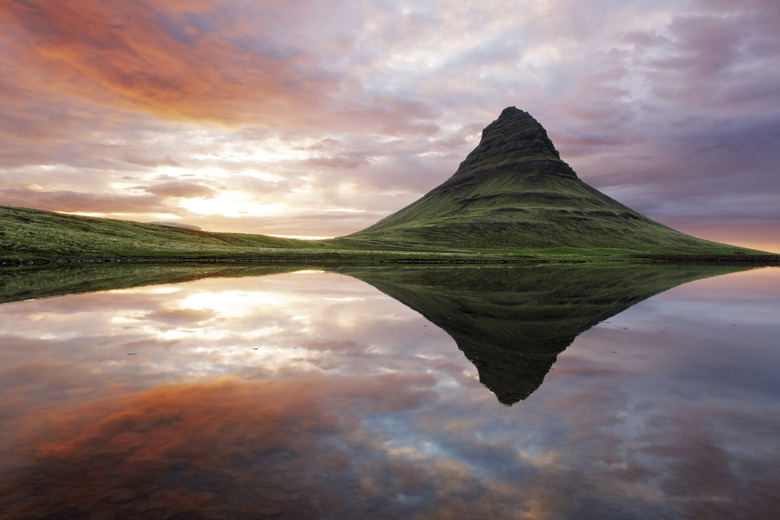Forces That Cause Landforms
How are landforms created? A landform is defined as a feature created by nature on the surface of the earth, and a typical landforms list includes geographical features like mountains, deltas, canyons, valleys and volcanoes. Landforms are created and shaped by a variety of forces over an extensive period of time, becoming distinctive and recognizable by their unique appearances. In general, landforms are created by a combination of constructive and destructive forces. Constructive forces build landforms up, while destructive forces wear them away.
Forces That Construct Landforms
Forces That Construct Landforms
The forces that build landforms up are called constructive forces. Constructive forces include plate tectonics and deposition.
Plate tectonics is a scientific theory that helps explain how landforms are created on the surface of the planet. This concept theorizes that the outer shell of the earth is made up of several plates that fit together like puzzle pieces. These tectonic plates move and shift, gliding over the mantle of the planet, which is a layer between the core and the crust. As the tectonic plates collide and drift apart, they create mountains, trenches and volcanoes through the folds and faults that occur in the rocky layers of the earth's surface.
Deposition is another constructive force. Through the laying down of sediment like soil, sand and pebbles, deposition also helps build up landforms. Sediment can be carried by water, ice, wind or gravity. Deltas are a type of landform usually created by deposition. Forming where rivers meet calm bodies of water, deltas are made up of the sediment that is deposited at the mouth of a river over a long period of time.
Forces That Destruct Landforms
Forces That Destruct Landforms
While constructive forces build landforms up, destructive forces wear landforms away and shape them at the same time. There are two main types of destructive forces: weathering and erosion.
Weathering refers to the slow decomposition of rocks and minerals. There are two main categories of weathering: physical and chemical. Physical weathering is when rocks are broken into smaller pieces, and it is generally caused by the expansion and contraction caused by the freezing and thawing of water in cracks and crevices of rocks. The second type of weathering, chemical weathering, changes rocks through chemical reactions and causes them to rust or dissolve.
The other main deconstructive force, erosion, refers to the geological process by which small pieces of rocks are carried to new places to create landforms. After weathering breaks rocks down, particles of soil and rocks are transported by wind, water and ice through the process of erosion. Rivers, valleys and coastal cliffs are created through the deconstructive force of erosion.
Earth's Landforms List
Earth's Landforms List
A basic landforms list includes four major types of geological features: mountains, hills, plateaus and plains. Mountains are landforms that rise in elevation above the land around them, and hills are smaller versions of mountains. Plateaus are flat expanses of land that rise above the surrounding landscape, and plains are large areas of flat land at sea-level elevation.
Beyond this major landforms list, there are dozens of other types of naturally created geological features on the surface of our planet. These minor landforms can be divided into five categories, which relate to the areas where they exist. The five categories of minor landforms are desert, coastal, oceanic, mountain range and volcanic.
Examples of desert landforms include dry lakes, dunes and sandhills. Just as landforms are created on dry land, they also occur in and around bodies of water. At the edges of oceans, coastal landforms like beaches, barrier islands, capes, fjords and sea cliffs are found. Under the water of the ocean, natural features such as coral reefs, inlets, sounds and mid-ocean ridges are created by geological forces.
In mountainous areas, landforms like buttes, canyons, passes, summits and valleys can be found within, between and around the ranges of mountains. And minor landforms also occur around volcanic formations as a result of flowing lava, both on land and underwater. Volcanic landforms include geysers, crater lakes, oceanic trenches, vents and volcanic islands.
Cite This Article
MLA
Sloane, Christina. "Forces That Cause Landforms" sciencing.com, https://www.sciencing.com/forces-cause-landforms-8126393/. 30 September 2021.
APA
Sloane, Christina. (2021, September 30). Forces That Cause Landforms. sciencing.com. Retrieved from https://www.sciencing.com/forces-cause-landforms-8126393/
Chicago
Sloane, Christina. Forces That Cause Landforms last modified August 30, 2022. https://www.sciencing.com/forces-cause-landforms-8126393/
